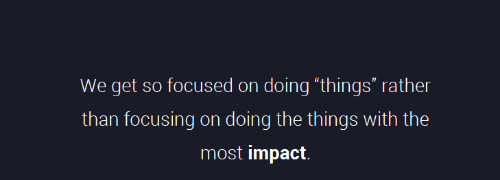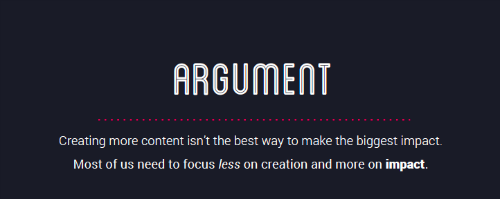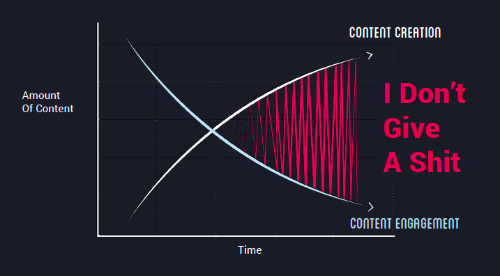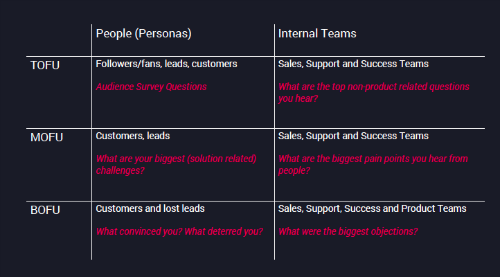
The problem with most marketing teams isn’t a lack of ideas. It’s a lack of clarity and focus.” – Hana Abaza
The meaning of the expression “less is more” is one that many content marketers are still struggling with. In an effort to capture the attention of busy and distracted consumers, they’re creating more content than ever.
But more isn’t always better.
Uberflip’s amazingly talented and entertaining VP of Marketing, Hana Abaza opened up day two of the Uberflip Experience conference to have a frank conversation about content marketing supply and demand.
Marketers Are Focusing on the Wrong Things

Here’s the harsh (and somewhat funny) reality for marketers:
- 90% of marketers think they’re productive, but they also work on weekends. (Workfront & Harris Poll)
- 60% of marketers have delayed going to the bathroom to meet a deadline.
These statistics have marketers wondering “How did we find ourselves in this position?”. The answer: We aren’t focusing on impact; we’re focusing on getting things done.
The 2016 Benchmark Report from MarketingProfs and Content Marketing Institute found that 76% of B2B marketers will produce more content this year. But many are still unable to measure the impact.
Hana suggests that maybe creating more content isn’t the best way to make the biggest impact.
How to Define Content Impact

Three questions that all content marketers should ask themselves include:
- Is my content in front of the right people?
- Is it driving quantifiable results?
- Is it the right content to begin with?
We are currently living in a very complex content environment. In fact, Hana’s research found that there are over 600,000 articles about mind-blowing marketing blog posts and almost 500,000 ultimate guides.
In order to be successful, we need to expand the scope of what we think of as content and take into account the content that is being sent to individuals on a one-to-one basis.
Flipping the Perception of Content Creation

In addition to marketers creating heaps of content, consumers are creating more content than ever before. And that consumer created content is what is diverting your audience’s attention away from you.
In fact, within the last year alone, Tumblr, Pinterest and Instagram have all experienced significant increases in their user base. Consumers are also consuming a crazy amount of video on these and other social platforms.
Because of this, people are engaging less and less with content that is not relevant for them, because they can.
3 Helpful Tips for More Strategic Content Marketing

#1 – Relevance
When we’re looking at content it’s not about quantity, it’s about quality. And it’s not just about quality; it’s also about relevance. Good content is no longer good enough. The content has to be relevant to the person, at the right time, on the right channel. Hana described the following three ways to validate content relevance:
People: The people that you should look at and reach out to include your internal teams, customers, prospects and followers/fans. You can reach them in a variety of ways including surveys or even quick and simple conversations.
Tools: To aid in your content planning, it’s important to use the right set of tools. Tools like BuzzSumo can help you understand what type of content is blowing up and resonating well with your target audience. Other tools like Answer the Public can help take the guesswork out of your content topics by providing insight into the types of questions that people are asking about a particular topic.
#2 – Distribution
Unfortunately, many marketers are focused purely on engagement metrics instead of incorporating important growth metrics as well. When marketers begin tailoring the content experience that will change the strategy for distribution. Here’s how:
Distribution Strategy Example:
- Our Subscribers
- Targeted Social (paid & unpaid)
- Influencers (Advocate Hub)
- Partners (Co-Marketing)
- Discoverability (SEO)
- Content Syndication (lead gen)
- Other Publishers (lead gen)
- (Very) Targeted Email
#3 – Experience
Here’s Hana’s dirty little secret. Great content isn’t enough. You need an experience that is optimized for your goals. The example she used was the difference between enjoying a nice frosty pina colada in a dingy basement, or out on a beautiful beach. Which one do you think creates a better experience?
In order to create a great experience, your content needs to be:
Readable: Content should have short paragraphs, great images and be easy to consume on a mobile device.
Actionable: Without setting up an engagement path for your readers, how will you lead them to consume more content or take action?
Tailored: There are a variety of different ways that you can organize content to meet audience needs. A few options for how you might segment it include:
- By Role
- By Industry
- By Audience Segment
- By Campaign
- For a Specific Prospect
Before You Write One More Word…
Prioritizing content creation when it seems like there is always so much to create can be stressful. But before you write one more word, Hana suggests answering yourself the following questions: Do you really need another blog post? How can you leverage what you have?
You can find Hana’s full presentation on SlideShare or by viewing the embed below:
How do you define the impact of your content marketing? Are you reaching your goals or missing the mark?


